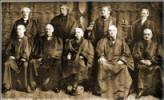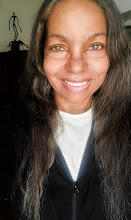When I was a child I heard all kinds of truths and lies about what race was and was not, and tried to figure out where I fit into the messy equation. One day, my mother and I were walking to the store and the question spilled out of my month.
"Who is Jim Crow Anyway?"
 |
Sunny Nash, Six Years Old Sketch by Oklahoma Artist Farmer-Stockman Magazine |
"Keep white people and black people against each other?" I asked.
"Jim Crow can even keep people in the same family against each other," She said.
"I don't understand."
"People in the same group can be jealous of each other and try to hurt each other," she said. "Jim Crow was designed for that. Keep them fighting each other and they won't have time to fight us."
"I don't understand."
"Black people tearing each other down," she said. "Poor people fighting each other no matter what their color; girls jealous of each other because one has a prettier dress or longer hair."
"I don't understand."
"All the fighting and squabbling is Jim Crow's trap!" She said. "Don't get caught in it. It takes too much time and never amounts to anything but mess for no real reason."
Did Jim Crow make up race? I asked my mother.
She took a while to formulate her answer. I could tell she was going to be careful about what she said. This was not the same kind of question she had grown accustomed to my asking when I was that young. I asked a lot of questions, so many that, sometimes, she simply told me, "Shut up!" Then apologized for being rude.
"Why are you asking such a question?" She threw it back to me. "You're six years old. Where is this coming from?"
"Why are you asking such a question?" She threw it back to me. "You're six years old. Where is this coming from?"
My mother never minced words when talking to me or sugarcoated any subject or ever talked baby talk to me. She simply gave me big chunks of information, sometimes in very raw form. When she came up with her answers for my endless questions, she always threw a question back at me. While I was coming up with my answer to her question, she had time to come up with the answer to my original question. The longer it took her, the more detailed her answer would be. However, my answer to her question had to be pretty good or she would throw me another question. And I could never repeat my original question, to which her response would be:
"I heard you the first time!"
So, I waited patiently for her answer. My mother was very smart and read everything. She bought reference books and subscribed to newspapers and magazines, some were black publications that covered the horrors of life in the southern United States, including Emmett Till, the little boy who had been beaten, tortured and found in the Tallahatchie River with a cotton gin fan tied with barbed wire around his neck. Pictures of his brutalized body were published in the black magazine, Jet.
"He wasn't much older than you," my mother had told me. "Jim Crow did that."
"Who is Jim Crow," I asked.
"The monster Rosa Parks is fighting!"
"Rosa Parks is fighting a monster?" I asked.
"Not like the monster under your bed," my mother shouted.
"There's a monster under my bed?" I shouted back!
"Shut up!"
 |
| Jim Crow Minstrel Character |
Based on a slave song, Jim Crow represented oppressive laws and helped to sustain a degraded image of African Americans and their existence, in which they were trapped. The Civil Rights Act of 1866 passed over President Andrew Johnson's veto. Andrew Johnson, Abraham Lincoln's vice president and successor when Lincoln was assassinated after the Civil War.
The Civil Rights Act of 1866 declared, "all persons born in the United States were now citizens, without regard to race, color, or previous condition. As citizens they could make and enforce contracts, sue and be sued, give evidence in court, and inherit, purchase, lease, sell, hold, and convey real and personal property. Persons who denied these rights to former slaves were guilty of a misdemeanor and upon conviction faced a fine not exceeding $1,000, or imprisonment not exceeding one year, or both."
 |
Nine Supreme Court Justices
Decide Plessy v. Ferguson
|
 |
| Lynching of African American Laura Nelson 1911 Oklahoma |
Jim Crow activities by the Ku Klux Klan undermined the act in the United States in the late nineteenth century, and the act failed to guarantee civil rights for former slaves, including female African Americans who suffered retaliation for speaking out for their civil rights. Because many victims of lynching were females, black women led the outcry against racially motivated lynching, a key to enforcing the Jim Crow system of government in most parts of the officially segregated South and, to a large degree, in the unofficially segregated North.
 |
| Anti-lynching Crusaders NAACP Button, 1900 |
In the 1890s, journalist, Ida B. Wells (1852-1932), wrote in protest of lynching and later the Anti-lynching Crusaders, a group of black women within the National Association for the Advancement of Colored People (NAACP), made a lot of noise against this Jim Crow criminal practice, until the Legislature took on the problem in 1918 in a bill intended to punish state, county and local officials who did not stop lynching in their locales and create an atmosphere to end the practice altogether. Although the House of Representatives passed anti-lynching laws three times, none of the efforts passed in the U. S. Senate. The Senate finally apologized on Monday, June 13, 2005, for not passing anti-lynching laws over the course of its history.
A second attempt at civil rights legislation to combat Jim Crow was passed in 1868 in the form of the Fourteenth Amendment to the Constitution. Section I of the amendment sums up its meaning and intentions. “All persons born or naturalized in the United States and subject to the jurisdiction thereof, are citizens of the United States and of the State wherein they reside. No State shall make or enforce any law which shall abridge the privileges of citizens of the United States; nor shall any State deprive any person of life, liberty, or property, without due process of law; nor deny to any person within its jurisdiction the equal protection of the laws.”
 |
| African American Schoolhouse South Boston, Virginia 1920s & 1930s |
In 1954, Brown v. the Board of Education made another attempt to destroy Jim Crow. The U.S. Supreme Court in Brown legislated: “Segregation of white and Negro children in the public schools of a State solely on the basis of race, pursuant to state laws permitting or requiring such segregation, denies to Negro children the equal protection of the laws guaranteed by the Fourteenth Amendment--even though the physical facilities and other "tangible" factors of white and Negro schools may be equal.”
In the northern states where legal segregation had not been sanctioned by separate but equal, local Jim Crow enthusiasts controlled education, property ownership and voting rights as well as where people lived, where they went to school, where they worked, where they were born, how they were punished and where they were buried when they died. These laws and local traditions took away all of the freedoms former slaves had gained after the South had supposedly lost the Civil War and had wiped out all of the strides African Americans made during Reconstruction from 1865 through about 1877, when the federal government withdrew from the South all resources that financed efforts toward equality for the next 90 years.
"The same people who made up Jim Crow made up race," my mother finally said softly. "And it's now something we are all stuck with."
"What about Dr. Martin Luther King?" I asked.
"I'm afraid he's stuck with it, too."
"What if we changed Jim Crow's name?" I asked.
"Changing his name will not change him," she said.
###
________________________________________________
Thank you for visiting.
Please come again.
SUBSCRIBE & FOLLOW
|
Hard Cover
Amazon Kindle
|
 |
Sunny Nash is an author, producer, photographer and leading writer on U.S. race relations.
Sunny Nash writes books, blogs, articles and reviews, and produces media and images on U.S. history and contemporary American topics, ranging from Jim Crow laws to social media networking. Sunny Nash is the author of Bigmama Didn't Shop At Woolworth's (Texas A&M University Press), about life with her part-Comanche grandmother during the Civil Rights Movement.
Sunny Nash’s book is recognized by the Association of American University Presses as essential for understanding U.S. race relations. Nash's book is also listed in the Bibliographic Guide for black studies at the Schomburg Center for Research in Black Culture in New York; and recommended for Native American collections by the Miami-Dade Public Library System in Florida. Nash uses her book to write articles and blogs on race relations in America through topics relating to her life--from music, film, early radio and television, entertainment, social media, Internet technology, publishing, journalism, sports, education, employment, the military, fashion, performing arts, literature, women's issues, adolescence and childhood, equal rights, social and political movements--past and present—to today's post-racism.
© 2015 Sunny Nash. All Rights Reserved Worldwide.
www.sunnynash.blogspot.com
~Thank You~



No comments:
Post a Comment
Note: Only a member of this blog may post a comment.